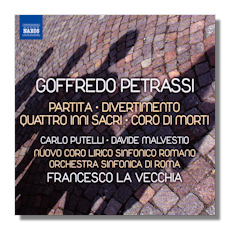
The Internet's Premier Classical Music Source
Related Links
- Petrassi Reviews
- Latest Reviews
- More Reviews
-
By Composer
-
Collections
DVD & Blu-ray
Books
Concert Reviews
Articles/Interviews
Software
Audio
Search Amazon
Recommended Links
Site News
 CD Review
CD Review
Goffredo Petrassi

Partita
- Divertimento in C Major
- Partita for Orchestra
- Four Sacred Hymns 1,2
- Coro di Morti 3
1 Carlo Putelli, tenor
2 Davide Malvestio, bass
3 Coro Lirico Sinfonico Romano
Rome Symphony Orchestra/Francesco La Vecchia
Naxos 8.572411
The music of Goffredo Petrassi isn't so well known as might be expected. His relatively varied career in a life that lasted almost a century (1904-2003) included composition, teaching, direction (of La Fenice in Venice), conducting, organist – and a desire to revive or build a distinctly new Italian national style of music.
Petrassi's early experience as a chorister at the Schola Cantorum of San Salvatore in Lauro left a lasting impression. His early music is lyrical and has a gentleness to it that is ironically somewhat less sinewy and demonstrative than other of his Italian contemporaries. This CD from Naxos contains four works from the early and middle phases of Petrassi's career which are played with style and fulfilled promise by an accomplished assembly of Italian musicians.
The Divertimento in C major and Partita for Orchestra are purely instrumental works. They show the influence of composers like Hindemith, perhaps Bartók and even Butterworth, towards the end of the Pavanne in the first work [tr.3]. Both are fully tonal works written in 1930 and 1932 respectively. Full of color, orchestral detail and the use of contrasting instrumental families they are given more compelling treatments by the Rome Symphony Orchestra under Francesco La Vecchia than their perhaps unexceptional musical purpose warrants. The performances are full of drive; dynamics are exploited to convey a variety and maintenance of interest which Petrassi's music must be acknowledged to lack when compared with the symphonic works of composers like Shostakovich, Prokofiev, Strauss, Sibelius and others of the time. Instead of trying to confer upon the Divertimento and Partita the import and status of major symphonic poems (for they have that potential feel to them), La Vecchia leads his orchestra as far as the music will take them, makes the most of the somehow less than truly inquisitive direction in which Petrassi marches; yet never tries to make a showcase, or undue spectacle, of the overtly neoclassical music. Competence satisfies amply, when vision is potentially absent.
The four pieces on this CD are all of roughly equal length – around 20 minutes. The Quattro inni sacri ("Four Sacred Hymns") and Coro di Morti ("Chorus of the Dead") were written later – in 1942 (revised 1950) and 1941/42 respectively. Here soloists Carlo Putelli (tenor) and Davide Malvestio (bass) are added in the former and the Coro Lirico Sinfonico Romano in the latter. The "Hymns" are just as "assertive" as the orchestral works on the CD; though they make a virtue of varied dynamics and color too. The texts are sacred, the tenor taking the first two and the baritone the last two. Each singer is somewhat distantly-miked. It's not hard to hear the words; but the declamatory style of each runs the risk of losing a little of its impact by this balance. There is greater tonal confidence – especially in the fourth Hymn, an excursion into mild atonality at times, almost. But not quite: the triumphal ending is decidedly conventional.
The "Coro" is sung by the Coro Lirico Sinfonico Romano (also with the Orchestra). In some ways its controlled extroversion and self-confidence sum up the tone of all the music on this CD. With a prominent part for piano, it's to a text by the now relatively unfashionable poet, Leopardi. Again the forces here make much out of Petrassi's determination to accent variety alongside an oratorical style with the never-overdone appearance of unsyncopated solo and ensemble brass, insistent snare drums and swelling strings. Again the chorus itself seems a little too distantly-miked. The subtitle for the piece is "Dramatic Madrigal". La Vecchia respects this nicely in a pleasing blend of the demonstrative with the nevertheless quite unflorid (yet not plain), the music being taken at a tempo which brings out nuances (transitions between passages, for example) which might otherwise have been lost if the rhetoric of the text had been allowed to dominate the slow unfolding of the piece for there are many places where it develops purely instrumentally. The ending is pensive and, once more, adds to any impact which the piece makes. In other words, these performers make the most of music that many would see nowadays as unselfconsciously conservative.
The acoustic is a little on the dry side; somewhat "contained", that of the Auditorium di Via Conciliazione in Rome. But nothing is lost. The booklet is in the familiar Naxos style: much material, including brief artists' biographies, fitted into just over three pages with the texts of the vocal and choral works in Latin and Italian with English translations.
Copyright © 2013, Mark Sealey





















